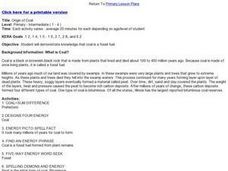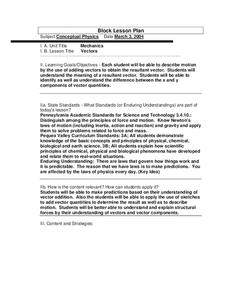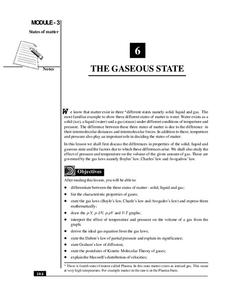Curated OER
Uncertainty Worksheet
In this uncertainty worksheet, learners solve 8 problems of addition and subtraction using the rules for uncertainty notation. They do the same for 7 problems for multiplication and division. Students add, subtract, multiply and divide...
Curated OER
Even More Significant Figures
In this significant figures learning exercise, students solve 12 multiplication, division, addition and subtraction problems and express their answers in scientific notation with the proper number of significant figures.
Curated OER
Significant Figures: Part Deux
In this significant figures worksheet, students solve addition, subtraction, multiplication and division problems and express their answers with the proper number of significant figures.
Curated OER
PROTOPLAST PRODUCTION
Students are allowed to strip away the cell walls of plants cells (using enzymes) and then observe the resulting spherical protoplasts (plant cells minus the cell wall). They see that plants cells indeed have a plasma membrane in...
Curated OER
How Do The Colors of Light Mix?
High schoolers investigate the mixing of light. They form a hypotheses to reason why color changes occur and they write conclusions and ask new questions arising from the investigation. Students identify the primary and complementary...
Curated OER
Electricity Layered Curriculum
Students describe how electric charges exert forces on each other as well as compare the strengths of electric and gravitational forces. They distinguish between conductors and insulators. In addition, students examine voltage and...
Curated OER
Mass
Students determine how mass is a property of an object that can be measured, and examine how size affects mass. They work with balances and determine what units of measurement are associated with mass. Finally, they determine the...
Curated OER
Coulomb's Law
Students solve problems involving electric charges and force. In this physics instructional activity, student solve word problems using addition and subtraction of vectors. They identify the direction represented by a vector as it...
University of Colorado
Solving a Mixed Up Problem
Begin the process of adding and subtracting spectra. Having a basic understanding of occultation events, pupils begin the pursuit to determine what a found atmosphere might contain. Learners work with two graphs and calculate what the...
Curated OER
Rounding Practice
In this rounding off practice, students determine the proper number of significant figures in numbers, in calculations of addition, subtraction and multiplication.
Curated OER
Food Chains and Endangered Animals
Students investigate how all links in the food chain are related. In this animal habitat lesson plan, students hypothesize about what would happen in the food chain if an endangered species were to become extinct. This lesson plan also...
Curated OER
What is Coal?
Students receive instruction to answer the question "What is coal?". They then participate in several puzzles and problems to explore the subject of coal. They solve addition and subtraction problems and match letters with the letter...
Curated OER
Geologic Time: Relative and Absolute Dating
Students investigate relative and absolute dating; determine the difference between the two dating systems; and apply this knowledge by creating a geologic timetable of their own.
Curated OER
Stage 1: What is Going into the Bin?
Student can explain the difference between biodegradable and non-biodegradable. They calculate how much rubbish bags all their families together produce each week and then calculate how much rubbish their families produce during the...
Curated OER
Protoplast Production (Plant Cells Without Walls)
Students explore the spherical protoplasts of plants. Students observe that plant cells have a plasma membrane in addition to the cell wall. Students plasma membranes, solutes and organelles.
Curated OER
Vectors
Young scholars describe motion by the use of adding vectors. They identify the difference between the x and y components of vector quantities. Students are given the Paper Bridge Building handout and the instructions as to where to...
Curated OER
A Botanists View
Young scholars explore plant and seed structure. They dissect a seed and identify its parts. In addition, they explain the function and compare and contrast monocotyledon and dicotlyledons.
NOAA
Mud is Mud...or is it?
We know that the type of soil varies by location, but does the seafloor sediment also vary, or is it all the same? Scholars compare photos of the seafloor from two different locations: the Savannah Scarp and the Charleston Bump. Through...
Curated OER
The Absorption of Solar Energy
Two sequential parts to this lesson introduce your class to the electromagnetic spectrum, the ability to absorb radiant energy, and the pigments in leaves that are responsible for collecting sunlight to be used in the photosynthetic...
Ahisma Summer Institute
The Power of One - Math in a Different Angle
In this 2-day lesson focused on exponents, middle schoolers will cross the curriculum by engaging in science, history and language arts activities. Exponential growth will be explored using grains of rice on a chess board. Exponential...
Discovery Education
Sonar & Echolocation
A well-designed, comprehensive, and attractive slide show supports direct instruction on how sonar and echolocation work. Contained within the slides are links to interactive websites and instructions for using apps on a mobile device to...
Cornell University
Nano What?
The size of a nanoparticle is difficult for pupils to grasp. A hands-on experiment is designed to give your classes perspective. Learners analyze different sports drinks for the content of electrolytes as an introduction to nanoscale....
National Institute of Open Schooling
The Gaseous State
Sixth in a series of 36, this lesson focuses on gases and their behavior in given situations. Learners review the states of matter and then focus on gases, specifically learning Boyle's, Charles's, Avogadro's Laws, Dalton's, and Graham's...
Curated OER
Revised: Adventures in Earth Day: Why Do We Care About Our Environment? - Biology Teaching Thesis
To describe the ecological and aesthetic importance of the Potomac River, Middle schoolers name the ways in which the river's values are jeopardized and explain the purpose of Earth Day. They write a response to a newspaper article in a...
Other popular searches
- Addition and Subtraction
- Addition and Subtraction Codes
- Addition Subtraction
- Addition Subtraction Inverse
- Addition and Subtraction Facts
- Decimal Addition Subtraction
- Addition and Subtraction to 20
- Addition Subtraction Puzzles
- Basic Addition and Subtraction
- Addition & Subtraction
- Addition Subtraction Math
- Addition Subtraction Lessons

























